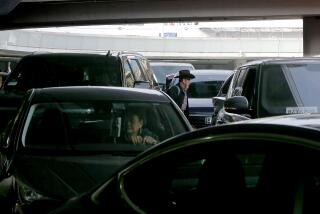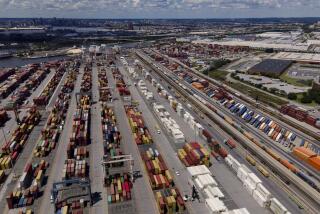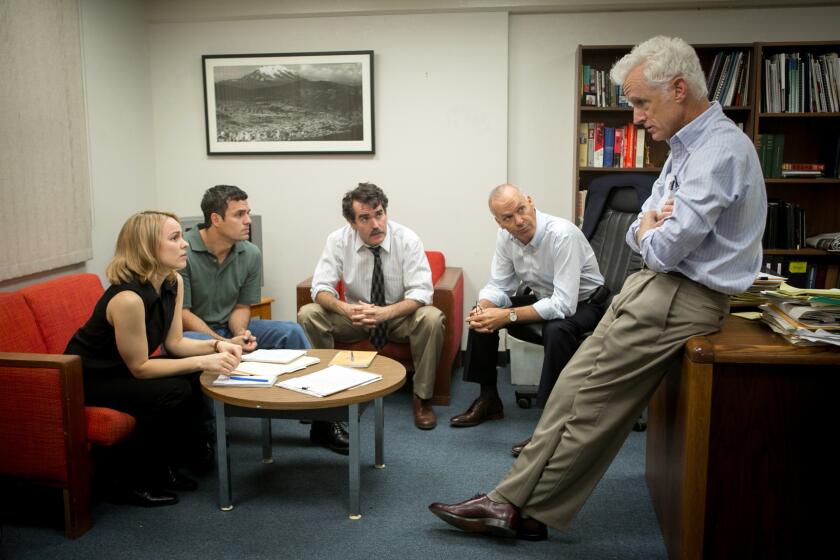Congestion worsens at L.A.-Long Beach ports as holidays near
The twin ports of Los Angeles and Long Beach are experiencing a logistical nightmare as they struggle to ease a bottleneck that could undermine retailers’ all-important holiday shopping season and threaten the competitiveness of the region’s economic engine.
In the worst shipping crisis in a decade, mammoth vessels loaded with products destined for the nation’s stores are sitting idle just off the coast, waiting for cargo languishing on the docks to clear.
“We have a meltdown on the harbor,” said Robert Curry, president of California Cartage Co., a trucking firm that serves the two ports. “Every day it gets worse.”
The delays are racking up costs for retailers, who have started to reroute their goods from the nation’s busiest port complex to other locations in the Gulf Coast, Pacific Northwest, Canada and the East Coast, said Jon Gold, vice president of supply chain and customs policy at the National Retail Federation.
Getting goods out of L.A. and Long Beach now typically takes seven to 10 days longer than normal, he said. There’s concern that some toys, apparel and electronics may not arrive in time for the holidays.
“This is an important time and we need fully functioning ports to make sure goods get to the store shelves,” Gold said.
The congestion stems from a surge of cargo before the holidays, the rise of massive container ships that are deluging the docks with cargo, and a shortage of trailers, or chassis, that truckers use to haul cargo from the ports to sprawling warehouses in the Inland Empire.
“This is really a perfect storm,” said Port of Los Angeles Executive Director Gene Seroka.
Ports around the country are facing similar issues. But the problems are magnified in Southern California. The twin ports handle about 40% of U.S. imports. If congestion continues unchecked, there are fears that their market share could decline as importers tired of the delays choose gateways elsewhere, perhaps permanently.
“It’s a black eye,” international trade economist Jock O’Connell said of the current bottleneck.
Some apparel and footwear companies are even flying goods into the country that would have arrived through L.A. and Long Beach, unwilling to stomach delays that have trapped goods inside the complex for two weeks, said Nate Herman, vice president of international trade at the American Apparel & Footwear Assn.
“The delays are increasing, they are not getting better,” he said.
Gold, of the retail association, said retailers are taking steps to prevent delays, including temporarily diverting cargo elsewhere and paying Southern California truckers more to pick up their goods first. But if congestion continues, importers may look elsewhere in the future.
“They might not come back to L.A.-Long Beach,” he said.
As of Friday afternoon, there were seven container ships anchored off the coast, waiting to call at the ports, according to Marine Exchange of Southern California. Some have been there for days.
A massive influx of cargo is stressing the system. In September, the Port of Los Angeles saw imports rise 11% from a year earlier, while next door in Long Beach import volume climbed 10.2%.
Adding to the congestion is the advent of ever-larger container ships, which have burdened terminals largely built for an age when ships were one-third the size, Seroka said.
“Vessels are taking a lot longer to work,” Seroka said. The shift to larger vessels “happened much faster than some of these [terminals] initially planned.”
Adding to the woes is a shortage of trailers. It’s “the root cause” of the congestion, said Port of Long Beach Chief Executive Jon W. Slangerup.
For decades, shipping lines owned these trailers. But in recent years, the lines exited the business nationwide and unloaded the chassis to third-party leasing companies. In Los Angeles and Long Beach, most of the shift occurred over the last year.
That has led to a shortage of chassis when they are needed, according to port officials.
One terminal may have a surplus, another too few. Truckers sometimes have to make multiple trips to locate a trailer. Previously, the shipping lines familiar with their supply chain were able to better plan for how many chassis were needed and where, O’Connell said.
The new chassis providers dispute the notion the shift has caused the dislocation and lay the blame largely on the rise of massive container ships, as well as a shortage of truck drivers.
The Port of Los Angeles is working with terminals to increase capacity and has also identified several parcels to store containers and repair chassis, in a bid to clear more space on the docks, Seroka said.
The Port of Long Beach this month directed staff members to devise a plan to purchase and supply truck chassis for use during peak periods. And it gave importers three more days to pick up cargo before storage fees kick in, in a bid to alleviate the financial pain.
Port officials say they see a possible solution to the trailer shortage in a massive shared pool, in which truckers could make multiple pickups with one chassis regardless of who owns the equipment. Now, a trucker may have to drop off a chassis, only to locate another chassis elsewhere in order to pick up an additional container, because trailer providers don’t have business relationships to serve the entire port.
According to port officials and others who work at the complex, the current congestion is the worst since 2004, a bottleneck that led to the creation of a system to encourage truckers to pick up goods at night.
The ports may get some breathing room to unclog the bottleneck when the traditional peak shipping season winds down at the end of October.
And by then the threats of importers to leave Southern California ports may wane. Also, many that did go somewhere else after last decade’s congestion crisis eventually returned, drawn back by the ports’ strong infrastructure and their location in relation to Chinese trade, O’Connell said.
Seroka, who was a shipping line executive before taking the top L.A. port post, said the port is taking the threats seriously. A third of the cargo traffic coming into Los Angeles could go elsewhere, he said. He expects heavy traffic to last until mid-November.
“We will help fix this,” he said. “This is our highest priority.”
Twitter: @khouriandrew







